Football in America: A Growth Sport in Arizona

Welcome to The MMQB’s eight-part series, “Football in America,” in partnership with State Farm. We’ll take the temperature of the game at the youth, high school, college and NFL levels in a changing landscape for the sport, in eight locales across the United States. This week: Episode V—Arizona.
Episode I: The Bay Area
Episode II: Carolina
Episode III: Minnesota
Episode IV: Dallas
Opening section about Bagdad High written by Kalyn Kahler. Video: Ryan Mitchell and Alex Nolen
COPPER AT THE END OF THE RAINBOW
Bagdad High, Bagdad, Ariz.
Friday 2 p.m.
On the drive along US 93 north out of Phoenix, radio stations turn to static fuzz and cell phones lose service. Cactuses the size of trees, and some as tall and skinny as telephone poles, grow at odd angles out of dusty red boulders. It’s the real-life setting of Disney World’s Thunder Mountain Railroad. There’s little traffic in the high desert of central Arizona, save for the occasional roadrunner’s dash across the winding highway.
Established in 1882, Bagdad is one of the few surviving copper mines from Arizona’s mineral rush of the late 19th century. (The town name? Urban legend: Back before its founding, a father and his son were out looking for ore, and every time they found some, the son said to the father, “Put it in the bag, dad.”) The majority of the mining camps of that era quickly became ghost towns when the copper or silver ran out and the mine shut down.
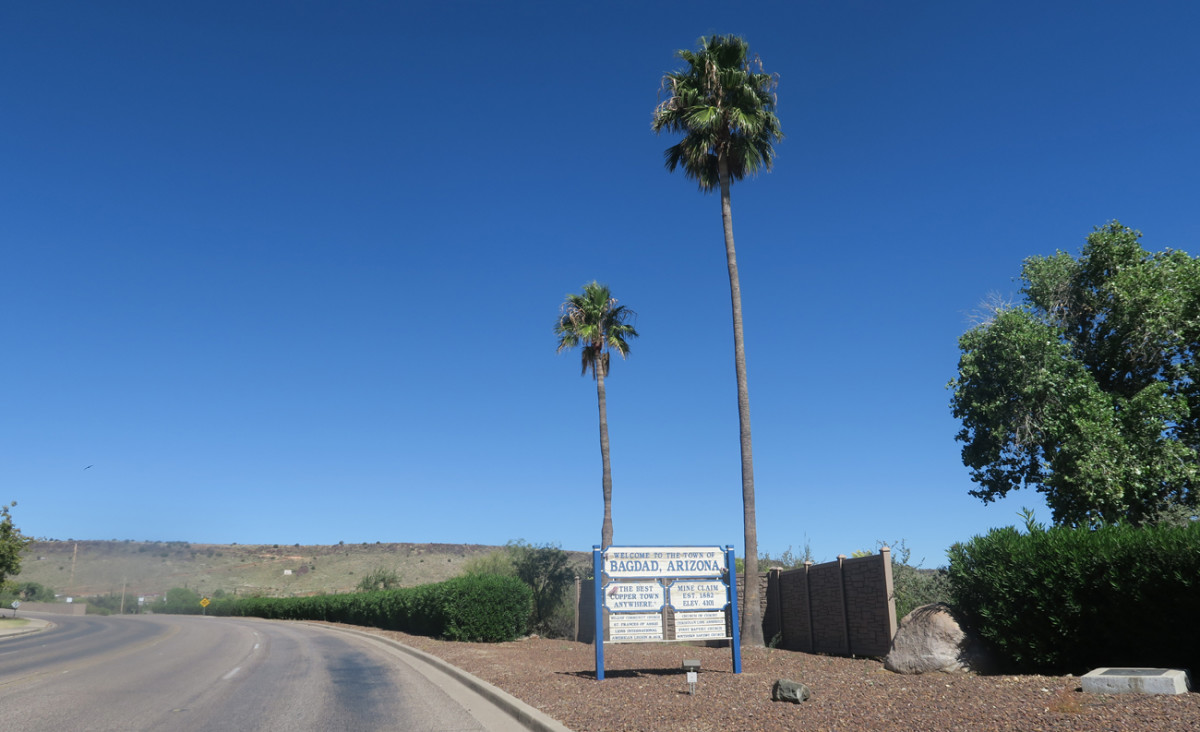
Surrounded by vast swaths of desert, Bagdad is the last place you’d expect to find a small-school football power with record-setting players. The Bagdad Sultans won the Arizona state championship in 8-man football in 2013 and again last season, and, fittingly, they commemorated the two titles with large flat sheets of copper etched with the season’s motto and the scores of each game. The sheets now hang on the wall at the entrance of the locker room. “I hope to fill up the whole wall,” coach Dalton Mills says. In Bagdad, copper isn’t just the rock stripped from the massive canyon on the edge of town. It is the town’s entire identity.
Freeport McMoRan, the company that owns the mine, also owns all the land in Bagdad and everything built on that land. The only people allowed to live in the town are employees of the mine or another town service such as the school or grocery store. Employees live in company-owned homes that are virtually all the same size and layout, except for the general manager’s much larger house on the hill. Rent is taken straight out of paychecks and runs about $300 per month for a three-bedroom, two-bath, 1500-square-foot home.
The mine operates round the clock, and the lowest-level laborers work 12 hour shifts for about $20 an hour. “It’s a dirty job,” says Ron Williams, Bagdad’s defensive coordinator and third-generation mine employee. “You have your truck driver jobs and your operator jobs, but your clean-up jobs, your labor jobs, it’s hard work. If you’re at the bottom of the pit in the summer it’s not uncommon for it to be 110 or 120 degrees.”

The Sultans football players mirror the hard-working mentality of their parents, the majority of whom work for the mine. “We always talk about being blue collar,” Mills says. “Your parents are out there working 12-hour shifts at the copper mine, and I think that work ethic is instilled in our kids, because they see their parents doing it.”
Three years ago, Mills switched from running a two-back power offense to more of a spread attack, and in doing so he set up senior quarterback Israel Loveall for a record-breaking career. As a sophomore, his first year as a starter, Loveall threw fifty touchdown passes. Before the start of this season he realized that the national record for 8-man football, 144, and the state record for all levels, 8-man through 11-man, 137, was well in reach. Loveall broke the state record in the Sultans’ sixth game of the season and the national record in the seventh. In the two weeks since, he’s experienced his 15 minutes of fame. “I’m enjoying it,” Loveall says. “We get a lot of attention not just for me, but for our program, what we’ve been able to do the past three years that I’ve been here.”
Loveall isn’t one to boast about his records. He’s a humble kid, one of five in his family, and the youngest of four brothers. His father is an electrician for the mine, and his mother is a bus driver for Bagdad schools. On Sundays and Wednesdays, Loveall and his family drive four hours round trip to attend church in Phoenix.
Small-college programs in the area have shown interest in Loveall, but he’s not planning to continue playing. “I just feel like I’m done after this year, and I already have my career planned out,” he says. “I love this town, but when I graduate I am ready to branch out. I’m probably going to move to Phoenix and become a helicopter pilot.”
Like Loveall, most Bagdad natives want to get out of town after graduation, for college or a job in a bigger city. But longtime residents are familiar with the predictable cycle. They sit back and wait for the inevitable return, because hardly anyone leaves Bagdad for good. “It’s funny to watch them do that,” says Israel’s dad, Michael, who left for two years after high school before returning. “I just saw a guy the other day at the mine and I’m like, wait, man, you came back to the end of the rainbow, huh? That’s basically what it is. It’s a secure job, it’s a good town.”
“Bagdad is kind of like its own little island,” says Mills, who was no exception to the rule. “I actually went to college so that I didn’t live here, because I grew up here.” Mills went to Arizona State to get his teaching degree and then returned to Bagdad in 2008 after spending about 10 years teaching and coaching in Phoenix.
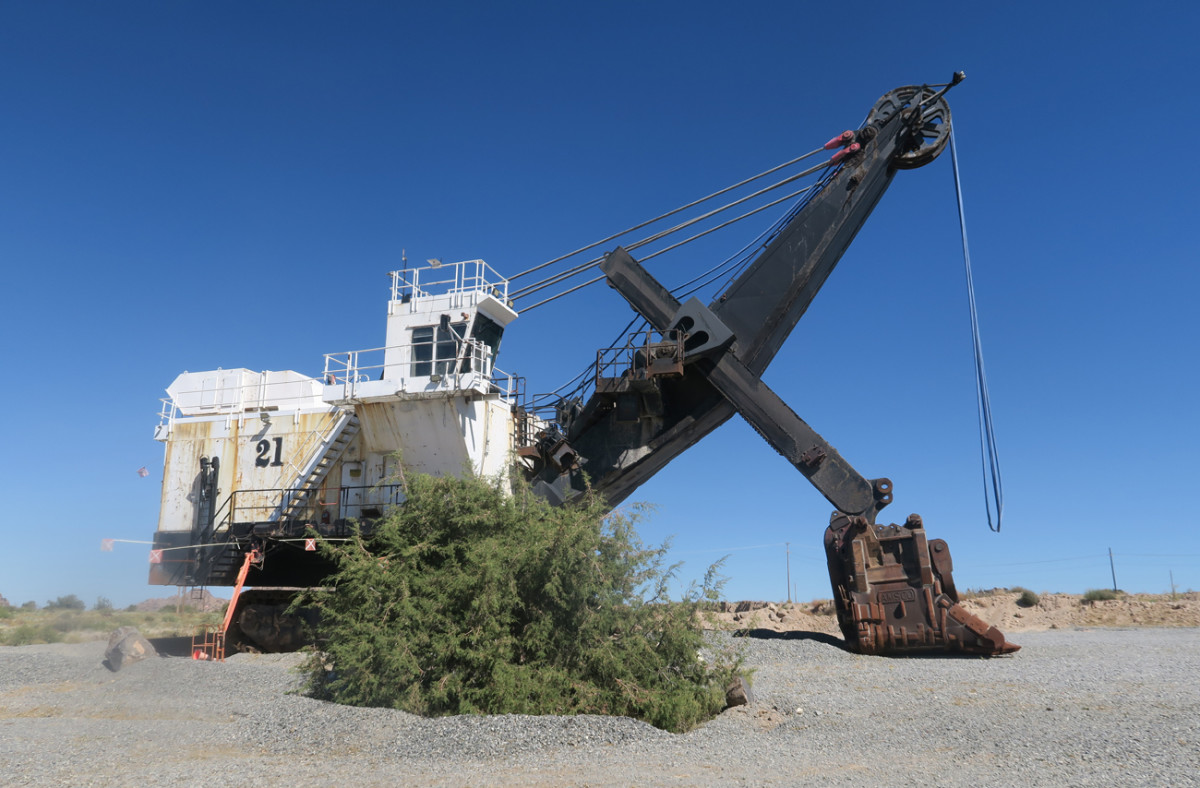
Tonight the Sultans travel to Mayer High, an old rival, to play their last regular-season game. Both teams are undefeated and battling for a high playoff seeding among the state’s 25 8-man teams. As the high school players stack their blue equipment bags and get ready to load the bus, one of Bagdad’s youth teams finishes practice on the field just down the hill behind them. While the high schoolers here play 8-man, Bagdad’s youth teams play 11-man and start out with tackle at age five. There’s no flag football program here. “When I went to school here [in the ’80s], this was more of a baseball town,” Mills says. “But now that we have youth programs, we’ve been really successful at it, and we’ve built success from the bottom up.”
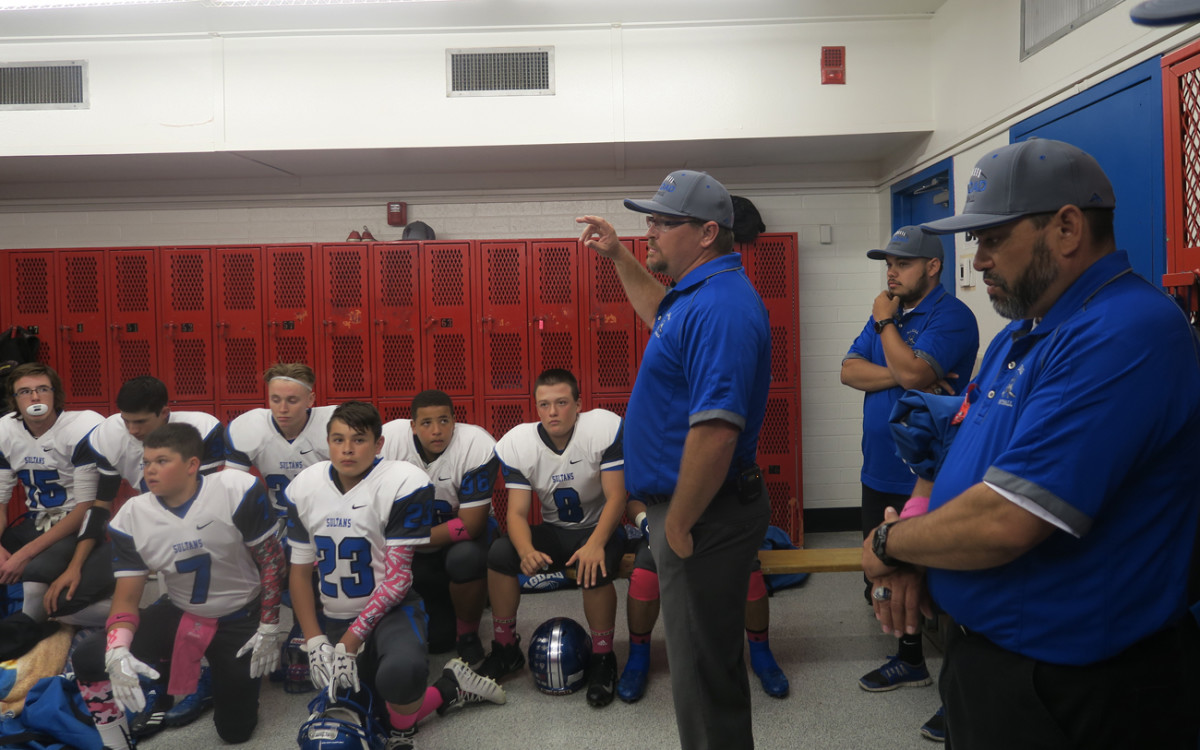
The 24 varsity players board the bus in matching BAGDAD FOOTBALL white t-shirts. Israel’s mom, Monica, sits in the driver’s seat and doesn’t react when her son passes her on his way to his seat. She’s a cool mom. “I just act like he is one of the players, I don’t even act like he’s my son,” she says.
Monica starts the bus and pulls out of the parking lot for the 95-mile drive to Mayer. It’ll take about two hours along the curving roads. Residents are used to long car rides—even the closest bank is an hour away. Says Michael Loveall, “If you grow up in Bagdad, you’re traveling.”
Mayer High, Mayer, Ariz.
Friday, 7 p.m.
Sultan players kneel in a half circle around their coaches in Mayer’s steamy visiting locker room before the game begins. “We’ve got two teams that are 8-0,” Mills tells his players. “We’ve got the contenders and the pretenders. We’re going to find out who the contenders are and who the pretenders are tonight.”
Bagdad scores on their first six consecutive drives. Loveall’s first touchdown comes on a quarterback draw. He drops back to fool the defensive line into thinking pass, then runs around the left side of Mayer’s defensive line, 60 yards untouched into the end zone. There are no offensive tackles in the 8-man game, and defenses play a 3-3-2, three defensive linemen, three linebackers and two DBs. Team speed a major advantage, as secondaries play man coverage and a fast receiver can easily exploit a mismatch. Loveall’s two favorite targets are quick senior receivers Rio Delgado and Scotty Finnerty.
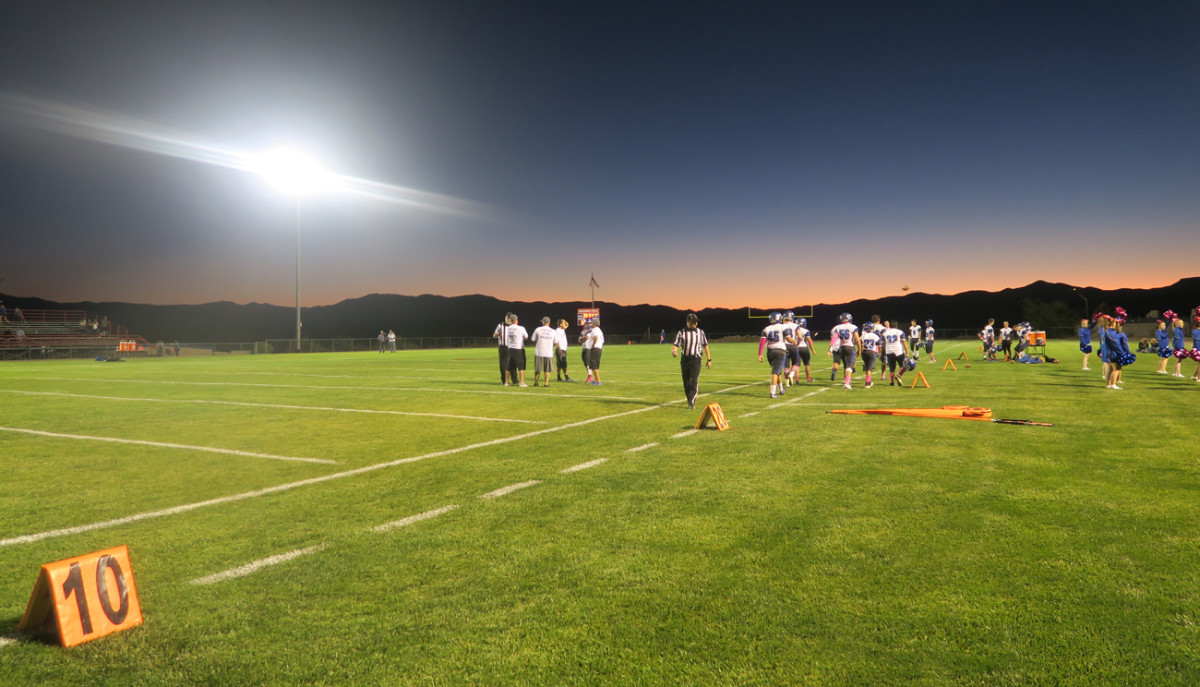
“I don’t think we’ve punted all year,” says Williams’ 13-year-old son, Cooper, who watches all the high school games from the Sultans’ sideline.
Each time Bagdad scores, the cheerleaders do a jumping jack for every point, always starting from zero each time. When Loveall runs in the two-point conversion following Bagdad’s eighth touchdown of the night, the cheerleaders exchange exasperated glances, as if to say, Here we go again. A few girls come up to the bleachers and jokingly give their cheerleading coach an excuse as to why they can’t physically continue doing jumping jacks. She won’t hear it.
Mayer is no match for Bagdad, and the Sultans roll to a 76-48 win. Loveall’s stat line for the night: 12 carries for 301 yards and six touchdowns, 20 of 28 passing for 396 yards and five touchdowns, with two interceptions. The Sultans’ decisive win earns them the No. 2 playoff seed and a first round bye.
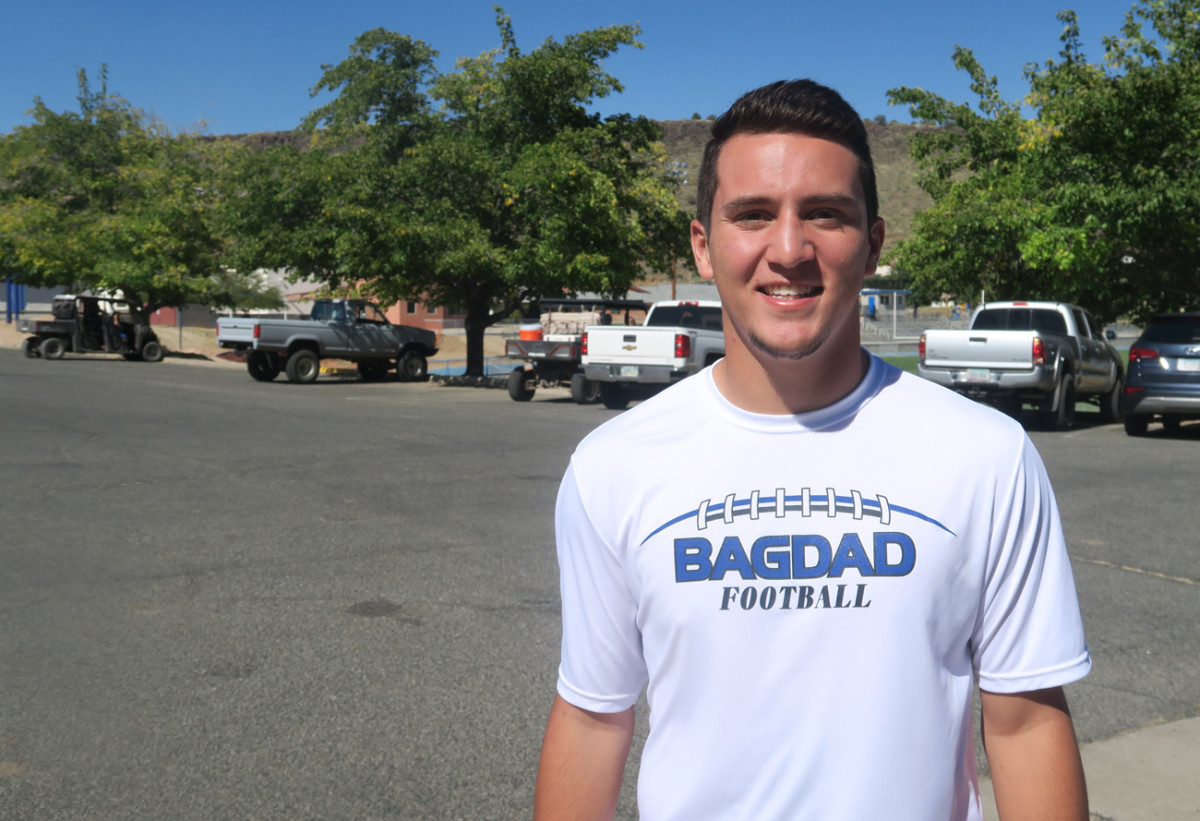
Still reveling in his quarterback’s otherworldly stats, Mills sends a text from the school bus back to Bagdad: “He’ll usually throw for four or five touchdowns a game and might run for one, but that was ridiculous. He just put the team on his back and carried ’em.” — Kalyn Kahler
BUYING IN AT AGE 10
Mesa, Ariz., Saturday, 6:30 a.m.
Yes, Coach!
All morning the refrain bellows from the Mesa Soldiers, a team of 10- and 11-year-olds who conduct themselves on the field in a manner that would rival even the most disciplined NFL team. Every one of the 19 Soldiers arrives at the Brimhall Junior High field promptly at 6:30 Saturday morning for the weigh-in; their opponent, the Jegos, trickle in slowly over the next hour. Thirty minutes before kickoff—as the Jegos run around one half of the field, pads off, playing tag and goofing around like you’d expect from a group of fifth-graders—the Soldiers are on their half of the field, already dressed in full uniform, running through plays, audibles and checkdowns.
Blast power left on one. Blast dive left on set. Blast fake power left reverse.
The man standing behind the quarterback and calling out those plays is Anthony Cordova, better known around these parts as Coach A.C. His 17-year-old son, Isaiah, is standing opposite him in front of the Soldiers’ offensive line, mimicking a blitzing opponent; he is one of Anthony’s four assistant coaches. Cordova actually wanted one more assistant—he always has a six-man staff—but couldn’t find one that he thought fit his program.
“This is not just a typical youth team,” Cordova says. “We are way more than that.”
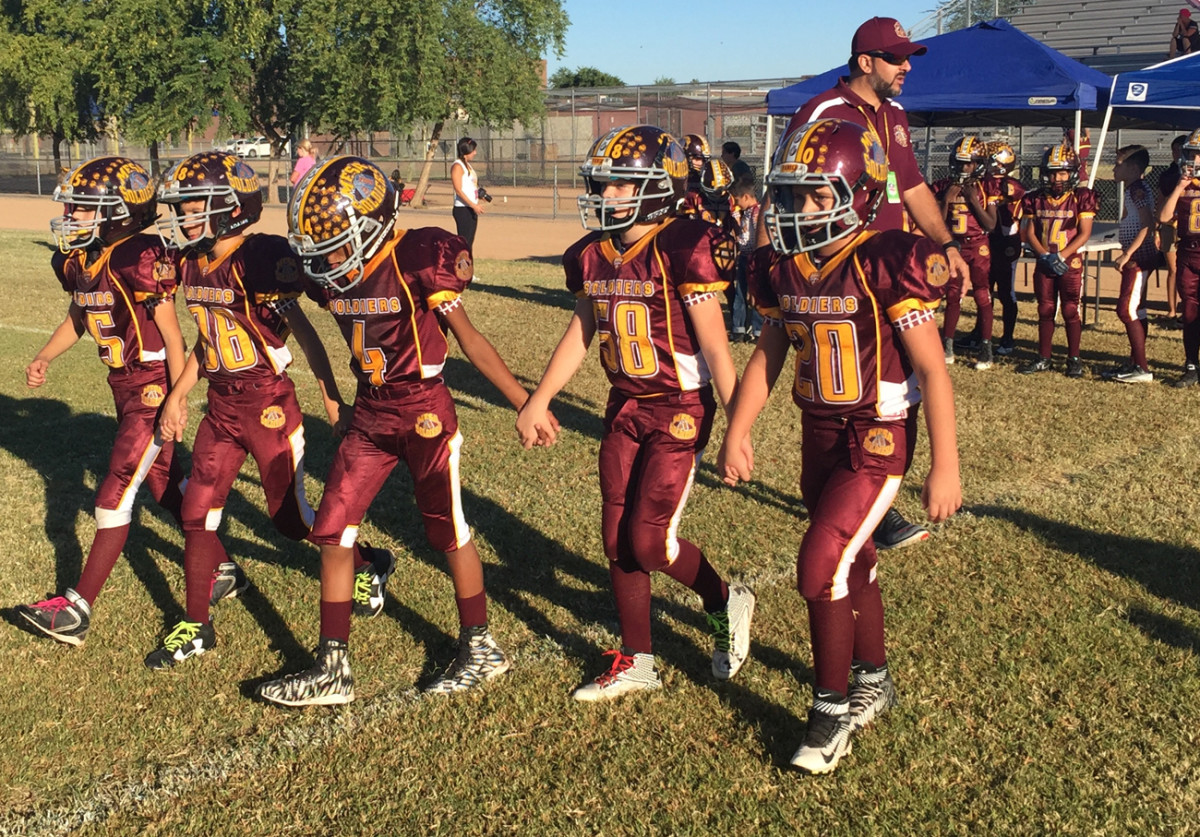
Cordova first got into coaching when he was in the Army, stationed in upstate New York. He joined a YMCA team as an assistant and instantly discovered that he had a passion for teaching. The Mesa Soldiers were established in 2003—it says so right on their helmets, beside the word Family—when Cordova began to coach his older son in the town’s youth league. He moved up with the team every year until he passed the squad off to the town’s high school coach. Then he did the same with his younger son’s iteration of the Soldiers, a group that Isaiah quarterbacked to an Arizona state title, played every year at Sun Devil Stadium, and thus a berth in Nationals, played in Florida, in both 2011 and ’12. After the second championship season, Isaiah decided to stop playing football, so Cordova went into retirement.
But four years out of coaching was too much. Even without a son on the team, Cordova decided earlier this year that he needed to return—and Isaiah, who deploys to the Navy next year, joined his father’s staff. Now the Soldiers are back and possibly better than ever. Heading into Saturday’s game they had allowed only seven points in seven games.
Even though the season didn’t start until late summer, Cordova met with all of the players and their parents way back in April. He laid out his expectations, described how his team would operate, and how, if they all bought in, players and parents, they’d be traveling to Florida to play for a national championship in November.
“I think they thought I was full of crap,” Cordova says. “They had never been exposed to a team that turns into a family.”
Then the Soldiers promptly embarked on an offseason conditioning program, sprints up a nearby hill, cone drills, footwork drills, pretty much an NFL minicamp. That’s also when Cordova began to instill the basics of his system and his philosophy: faith, family, school, football. The first thing he taught the kids were how to look him in the eyes and give a firm handshake. Cordova says he loves pissing off parents at first, because he then loves to see them buy in later.
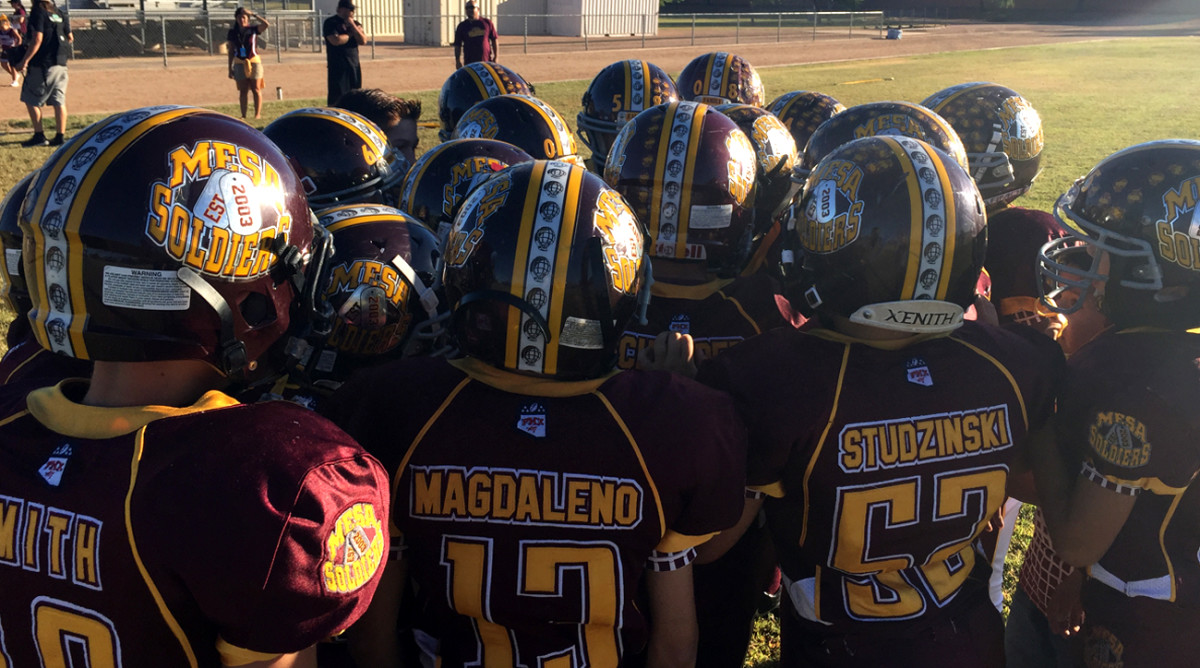
“I set the standards, the expectations, so high, and I’m such a disciplinarian,” he says, “that a lot of people get rubbed the wrong way in the beginning. But once they realize that I am going to follow through with everything I say, that I have your kids’ best interest at heart and I love them with everything I got, and then we start winning, and then they see the kids improve, then it’s a wrap. That’s when you build the team. Just like a family.”
As it nears kickoff, Cordova brings the whole team together on the sideline. They seem lethargic. He urges them to bring their energy level up—despite it being the final game of the regular season, playoff seeding is still on the line. After this, there are just three more playoff games and then the Soldiers would be heading to Florida—an outcome Cordova fully expects to be the reality.
“You have to go full speed. You have to give 100% of what you can give. Do you understand? “
Yes, coach!
“You’re the best team in the league. Do you understand?”
Yes, coach!
“If you’re not, you’re cheating yourself and you’re cheating your parents. Just two hours. That’s all I am asking. Don’t be scared to be great. It takes sacrifice and it takes hard work. Do you understand?”
Yes, coach!
The Soldiers’ five captains walk out together to midfield, hand in hand. They look their opponents in the eyes, shake their hands, and wish them good luck. Then the Jegos kick a low, bouncing kick and the game begins. The Soldiers are led on the field by running back Taveon Sueing, who breaks multiple tackles every time he touches the ball, jukes and evades most other would-be attempts, an Adrian Petersonesque combination of power and speed. But even the Soldiers’ best player gets chewed out by Cordova multiple times during the game for missed assignments or sloppy execution.
“Coach A.C. could be rough on you at sometimes, but he’s doing it for a purpose, he wants us to get better.” Sueing says. “[And] I hope to play in the NFL one day.”
Aside from Sueing, the Soldiers are not overtly superior athletes than their opponents. They are just simply more organized, more cohesive, more disciplined—and their coach less forgiving. When a cornerback is beat around the corner on a rush on the team’s first defensive play of the game, Cordova pulls him out of the game immediately and sends him off to the Soldiers’ defensive coordinator for reprimand. When an offensive lineman later gets called for a false start, he’s also yanked and sent to the line coach.
The authoritarian style does seem to pay dividends. With time running down in the first half, the Soldiers march down the length field; it’s a two-minute drill for 11-year-olds, which you’d think would be an impossibility. But as the Soldiers get near the goal line, with no timeouts remaining, they manage to run a no-huddle offense, rushing to the line of scrimmage and getting the snap off right before the clock hits zero. Touchdown. It is a methodical display of team proficiency that would have made Bill Belichick come as close to a smile as he is physically able.
The Soldiers win easily, 35-6, and would learn later in the day that they had earned the No. 1 seed in the playoffs. (The Jegos returned a fluke fumble for a touchdown in the second half, only the second score the Soldiers allowed all season.) Postgame, Cordova shakes hands with every one of his players and then brings the group together at midfield.
“We can’t give up touchdowns like that,” he says. “Got to put our foot down all game. Do you understand?”
Yes, Coach!
“Real easy guys, now it’s a new season,” he says. “Have a great week, listen to your teachers, listen to your parents. Two games we are at Sun Devil Stadium. Three we are on a plane.”
By this point in the season, the parents, who braved the Arizona heat on the sidelines or sitting in the stands under umbrellas, have indeed bought into the Soldiers’ system. Kenny Thorley says Cordova is the perfect type of coach for his son Cody, the Soldiers’ other running back.
“Coach A.C. is a tremendous leader,” Thorley says. “You have the timid coaches, like Henry Winkler in The Waterboy. Then you have the spastic screamers. Coach is not a spaz and he’s not timid. He’s direct and he’s honest.”
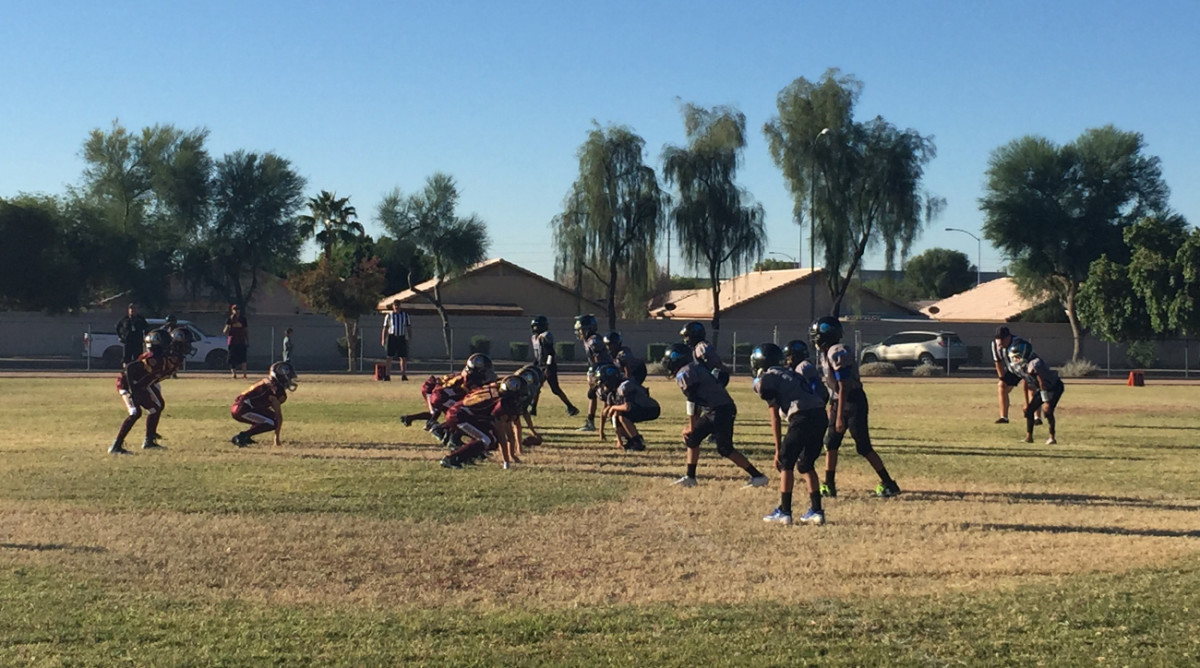
As for Isaiah, Cordova’s son, he says that he always tells his dad that he was made for coaching, that it is in his DNA. He wishes his dad would move up a level, telling him that he should coach in high school, or maybe even higher. But Cordova likes being where he is. He loves his Soldiers.
“You can have more of an impact with the kids,” Cordova says. “Then once they get to high school, they are ready.”
BOOM TOWN, BOOM TIMES?
Sun Devil Stadium, Tempe, Ariz.
Saturday, 4:30 p.m.
The towering cranes are visible from the tailgates all around campus, with old buildings constantly being razed, and then new ones constantly being built, bigger and better. All of the recent construction in the area has reshaped Tempe so drastically that some of the older alumni don’t even recognize their alma mater anymore.
“All around us here were empty blocks where people could park,” says Mitch Gonzalez, as he sits on a lawn chair at his tailgate spot, a small grass plot on the side of the road. “This area was nothing like this [when I was here]. It was a small college town. Now it’s a big city.”
Gonzalez, 66, arrived to his tailgate—about a five-minute walk from the stadium—with his wife, Rene, 65, at 5:30 a.m. That’s the only way they are able to reserve the area, as the rush of people begin claiming their places as soon as the sun comes up. Kickoff for Arizona State’s game against No. 5 Washington was 14 hours away when he first sat in his chair.
“We bleed maroon and gold,” Mitch says.
Mitch graduated from ASU in 1973, Rene in 1993. She ended up going back to school once her three boys were grown and off to college themselves. Although none of her children went to ASU, Rene did find herself on campus with some of her youngest’s friends; she says she became a nerd and got straight A’s.
Years ago the couple would bring their children to the games because it was cheaper than hiring a babysitter. Mitch first got season tickets in 1972, back in the days when you could bring a full cooler into the stadium. Over the years they have had to change their tailgate spot three times because new buildings were built on the plot of land where they had set up camp. They’ve been in their current spot for 10 years now and hope they are able to stay. And like most of the fans around the team, they are cautiously optimistic.
“We’ve see a lot of ups and downs, but I think the program is going the right way,” Mitch says. “It’s exciting times for ASU fans right now. The quality of players we are bringing in is much higher than before.”
The commercial improvements of the town of Tempe are reflected in the ongoing change of the school as well. A few years ago ASU transformed more than 615,000 square feet of space on various campus sites, constructing three new buildings. This year the school is undergoing a massive project that will reportedly bring 20,000 jobs and 5,000 residents to the area. It includes creating 1 million square feet of office space, urban residences, restaurants, a retail space, a parking structure and a hotel. The growth of the town and school has gone hand-in-hand with the growth of the football program, as Sun Devil Stadium is currently being renovated to the tune of $307 million. That includes a 120,000-square-foot player facility, replete with a 9,813-square-foot weight room sitting above a 1,924-square-foot deck for cardio training, a 5,347-square-foot training table area with seating for 160, a plunge pool with a waterfall that will hold 30 players, a players lounge, a barber shop, a nutrition bar, and a 5,387-square-foot sports medicine area.
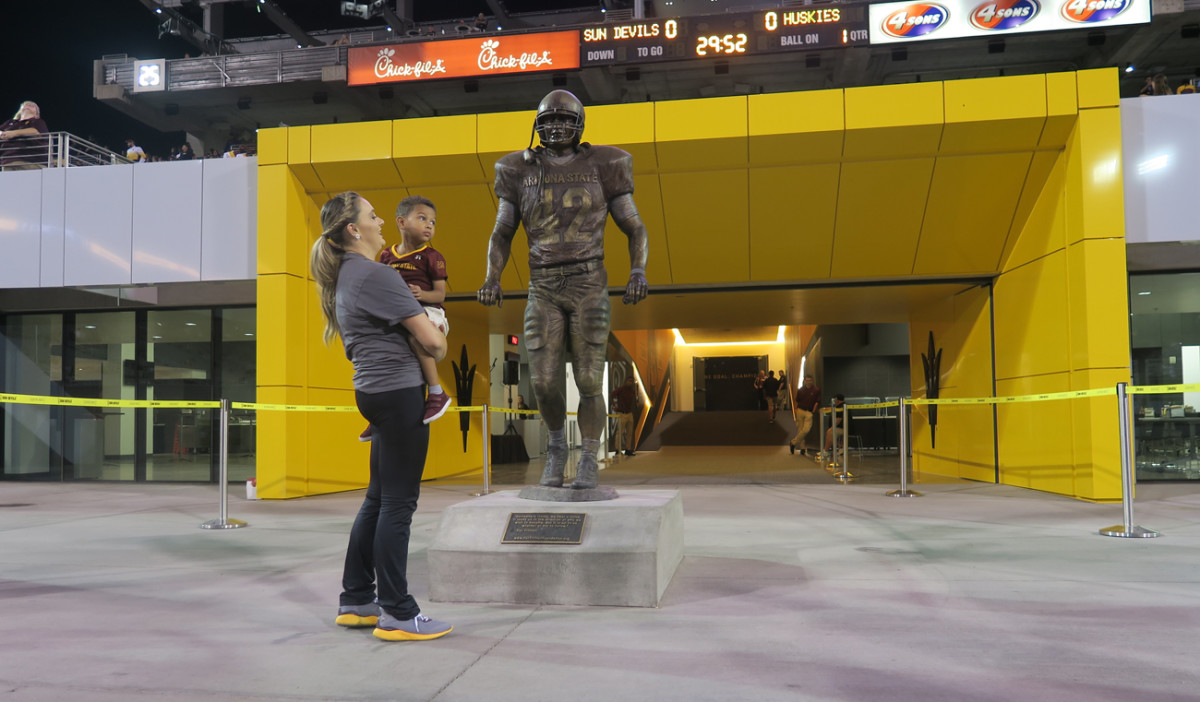
Todd Trickel has also seen that growth first-hand. He graduated in 1997 and was born and raised a Sun Devil fan. His parents had season tickets for 50 years, which he inherited 15 years ago. He’s gone to at least one road game each year over that span. He has noticed the level of talent of homegrown Arizona players increase exponentially over the years, evident in the fact that a lot of players are now traveling out of state for college and attending the blue chip schools; which makes him sad for ASU, but proud for the state.
“It has grown tremendously here,” he says. “Gotten a lot more competitive.”
Trickel’s tailgate spot is just down the road from the Gonzalezes, and he’s been there for 20 years. His group consists of six families, and every game they rotate which one must reserve the spot in the morning. They also all bring homemade meals; today they have meatballs—both Italian and Mexican—cold cuts, mac and cheese, and chips and salsa.
“It’s like New Orleans out here,” Trickel says, as a marching band comes rolling through the scene. “The atmosphere is awesome. It’s a lot of fun.”
On game days, and sometimes on other days, Trickel is known as The First Down Guy. That’s because about 20 years ago he noticed that nobody in the stands was doing anything after the Sun Devils earned a first down. So he started standing up in his seat and leading his section—Section 5—in a first down chant and exaggerated first down point. A tradition was born. Now Trickel is spotted at Diamondbacks games around town—Hey, that’s the First Down Guy!—much to his wife’s chagrin.
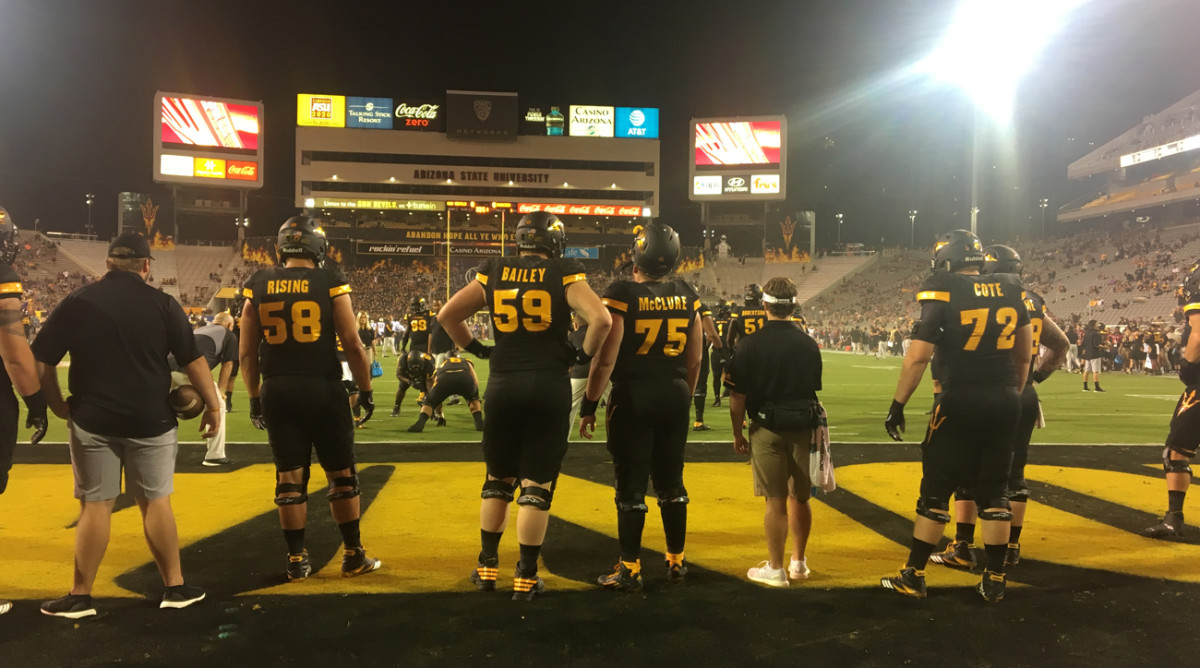
“She says I’m getting a big head,” Trickel says.
But it hasn’t always been all that fun and easy to be an ASU fan. “It’s been a roller coaster,” he says. “We invest a lot into it, but as of late haven’t gotten a lot of out it. We feel like the Cubs—next year will be our year.”
It turns out that, against all odds and prognostications, Saturday night is their night. Despite coming into the game as a 17.5-point underdog, despite having a much-maligned defense that had given up 30-plus points in each of the team’s five games so far that season and in an FBS-record 11 straight games dating back to last year, despite having lost 10 straight games to top-five opponents, despite facing a Huskies offense that had scored 30 or more points in each of the six games they had played that season—all wins—including 63 points in one contest, the Sun Devils dominate the game from start to finish.
Arizona State’s porous defense is stifling, harassing Washington quarterback Jake Browning all over the field and finishing with five team sacks and countless more crushing hits on the QB. The Huskies are held scoreless going into the fourth quarter; their kicker misses two kicks under 30 yards, the first time that has happened on a AP top-five team since 2010. In the end the Sun Devils win 13-7. The fans rush the field, after an odd five-minute delay as security tries its hardest to keep them off. Eventually they manage to bust down the gates, an ever-growing mass of students surrounding the squad in jubilance—the impending $25,000 fine for the transgression will happily be paid by the school.
An incredible upset, an incredible scene.
“We told ourselves for the past two weeks: believe,” ASU quarterback Manny Wilkins says after the game. “Why not us?”
FROM SNOWBIRDS TO CARDINALS CRAZIES
Sunday, 10 a.m.
Glendale, Ariz.
With the White Tank mountain range visible miles off in the distance, the party rages on the Great Lawn right outside of the University of Phoenix Stadium. The eight-acre expanse of grass stretches over 1,000 feet, providing Cardinals fans with one of the more unique tailgating experiences in all of the NFL. Three rows of sycamore trees line the area—just a small fraction of the 1,250 trees planted in Sportsman Park to provide shade, some respite from the oppressive late-morning Arizona heat. On the lawn, a six-man band (all clad in red shirts and blue overalls) plays, hundreds of tents are pitched, games of cornhole and beer pong rage throughout, and everywhere you turn there is another grill being fired up, the smell of sausage and burgers and beer pervasive. The individual tailgates are all separate, but the feeling is that of one of giant, communal party.
“The game-day experience here is second to none,” says Rick Acuna, a season-ticket holder since 1994, the first year the Cardinals arrived in Arizona. “The Great Lawn was a great idea. It’s a great atmosphere, a whole big family atmosphere.”
Acuna is a life-long Arizona resident—born in Gilbert and eventually moving to Mesa—and has come to the same tailgate spot with the same group of guys for the past 22 years. They make a full day of it, leaving their house around 8 in the morning and getting home around 7 at night. Early on in the franchises’s history in Arizona, Acuna says, the team didn’t have much of any home-field advantage. But that has since changed.
“The games would be like away games at your own stadium,” he says. “You don’t see that as much anymore. Now the home games are very much a Cardinals home game.”
That’s because Arizona is a state of transplants in many ways. And despite being the oldest continuously run professional football team in the U.S., the Cardinals have never been able to secure a strong team identity or a loyal fan base, as they’ve moved cities three times over the last six decades, from Chicago to St. Louis to the Phoenix area. For years, as new football fans moved in from other states around the country, they would remain fans of their old home team. But Acuna says that’s changing, crediting Michael Bidwill for overhauling the culture of the franchise since he took over ownership from his father.
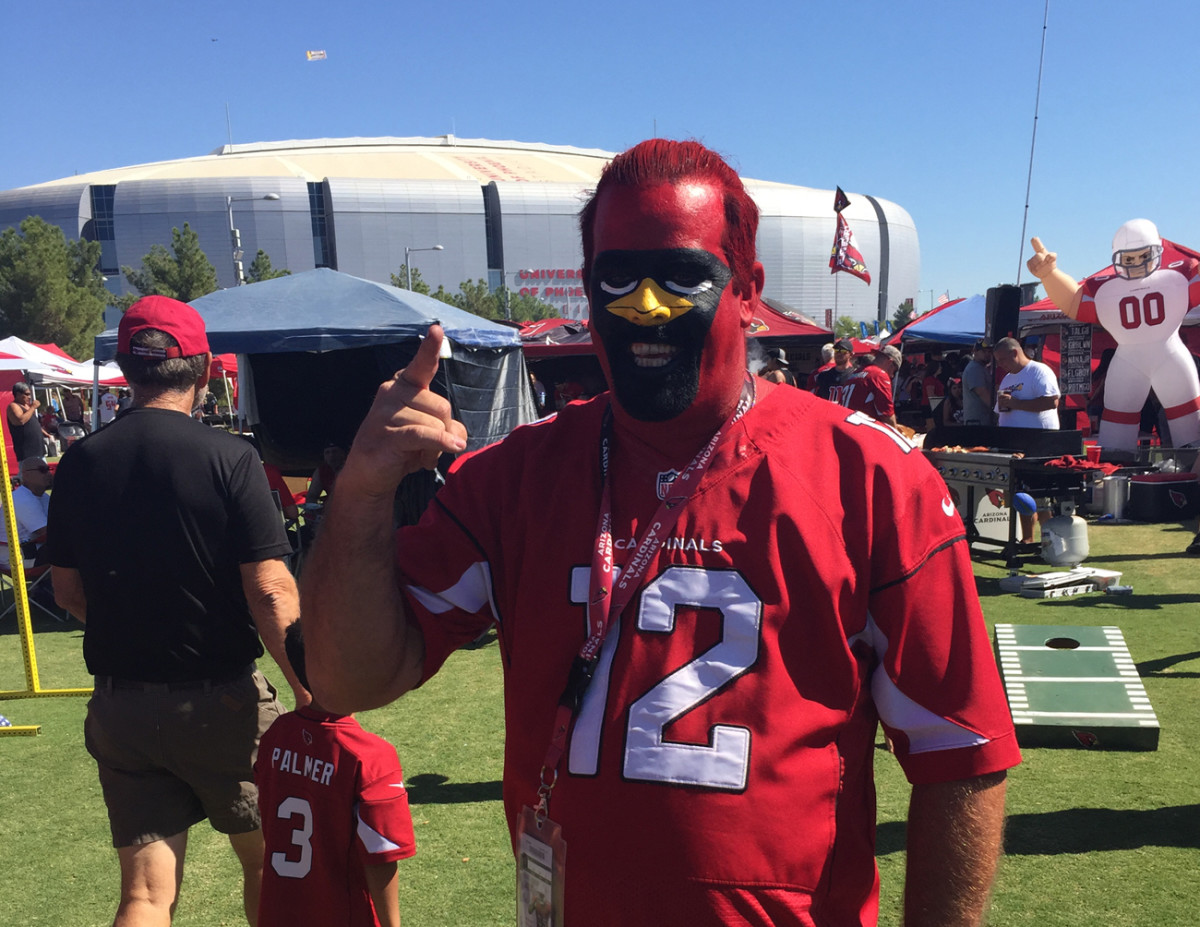
“It’s now the next generation of Cardinals fans,” Acuna says proudly.
Jet Jones moved from Ohio to Phoenix 21 years ago. Originally a Bengals fan, Jones says she embraced the Cardinals since the first day she arrived. She met her husband 20 years ago, and he had season tickets. They’ve been coming to games together ever since—their set up just down the Great Lawn from Acuna’s.
Jones’s party consists of about 40 people, and each family is assigned to bring a specific food each week. The group stays outside partying until right before kickoff, and then after the game they come back out and continue partying until they’re booted out. The biggest difference Jones notices over her last two decades coming to Cardinals games is the color red. Years ago half the stadium would be whatever the opposing team’s color was.
“It’s great to see more people that are moving here and are becoming fans of the Cardinals instead of staying fans of their [original] teams,” Jones says.
Casey Lusk, also known as the Jolly Bird Man, attributes that mostly to University of Phoenix Stadium. The venue, which opened in 2006 as the first football park in the country with a fully retractable roof, completely changed the game-day experience for Cardinals fans. Before the Glendalestadium opened, the Cards played home games at Sun Devil Stadium, and unlike ASU, which plays at night, the NFL team played during the afternoon.
“It’d be 110 degrees,” Lusk says. “I remember walking to a Packers game in Sun Devil Stadium, and a guy from Green Bay on the phone talking about how it was like a home game for them”— except much, much warmer. “It’s changed a lot now. [The fans] make a difference.”
Lusk earned his nickname because his entire face is pained red and black and his nose yellow—yes, like a cardinal. He’s been doing it for 15 years. The process used to take him two hours, but now he’s gotten it down to a science, cutting the time down to an hour and a half. He starts painting at 5 in the morning. And since he often goes out to a bar with friends after games, and it takes more than an hour to get the face paint off, he is usually the Jolly Bird Man until midnight.
“It’s the American Dream,” Lusk says.
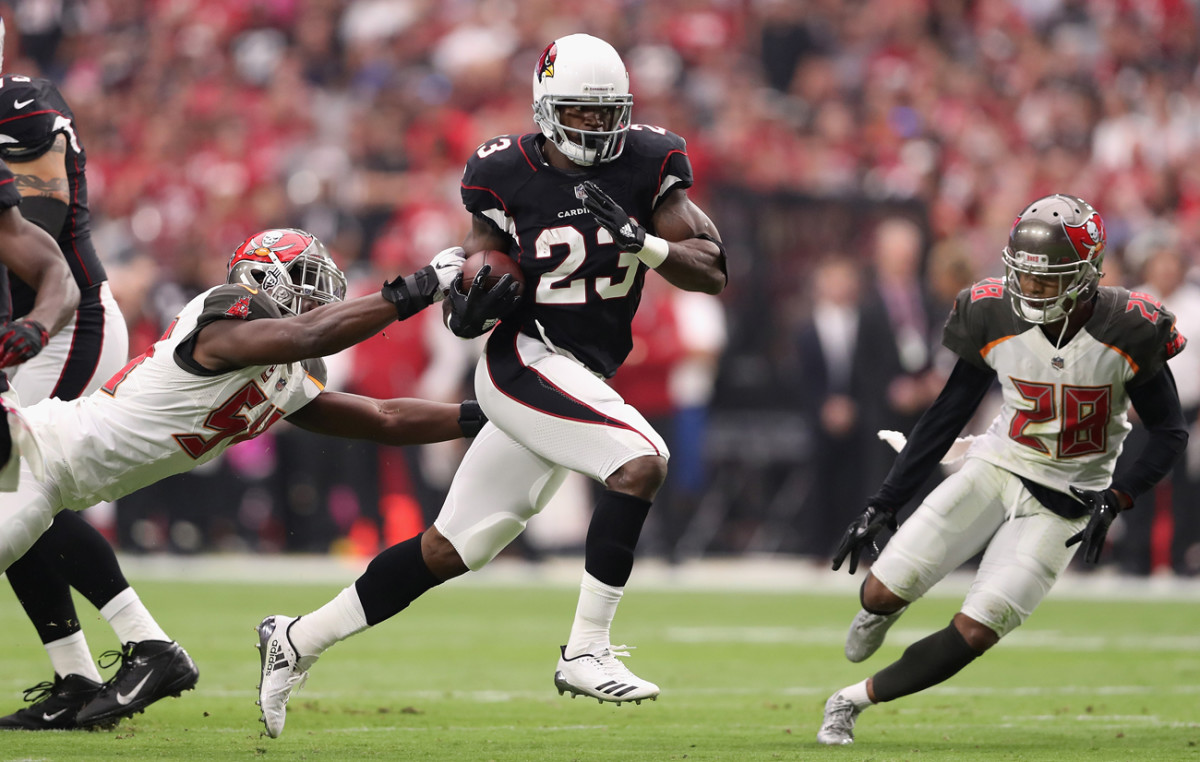
For Kimberely Thomas, it is also the Canadian dream. Thomas is from Wolfe Island, Ont., and is not technically a Cardinals fan, but is maybe the biggest Larry Fitzgerald fan in the world. A few years ago Thomas was watching a football game on TV with her husband and, well, let’s let her tell the rest.
“I just saw this vision go across the field, and I said who is that?” she says. He told her it was Fitzgerald, and a crush was born.
Thomas is in Arizona this weekend because a friend of hers told her that she had three two-bedroom condos available, if she wanted to come for a free vacation. Two weeks earlier she was watching football, and her husband paused the TV. He asked here where she was going. She said Phoenix. He asked her who plays in Arizona. She said the Cardinals. Then it clicked. She would be able to see Fitzgerald play in person. She spent more money on tickets to the game than she did on airfare. At the stadium she bought a Fitzgerald jersey, a Cardinals backpack, and a “#1 Fan” foam finger.
“It’s probably a waste of money,” she says, “But maybe [Fitzgerald] will see me and want to marry me.”
When asked if she thinks Fitzgerald will score a touchdown today, she says, well …
“He can score with me—my husband said so,” she says. “He said Neil Diamond and Larry Fitzgerald.
“[When I left Canada] I said goodbye to all my friends because I won’t be coming back. I have two beautiful granddaughters only a year old. But if Larry wants to marry me we will have to travel the world. We can visit them. I’m sure he has a helicopter.”
While Fitzgerald scores a second quarter touchdown (he would finish with 138 yards) as the Cardinals burst out to an early 31-0 lead against the Buccaneers—surely making Thomas extremely, um, excited—the day belongs to the newest Cardinal, running back Adrian Peterson. Despite being proclaimed dead and buried after a failed stint in New Orleans, Peterson runs for 134 yards and two touchdowns on the day. The game gets close late, but Arizona’s 38-33 win keeps the team alive in a narrow NFC West race, with the resurrection of Peterson bringing life to a moribund offense.
After the game, backup running back D.J. Foster stands at his locker. Foster is the only player on the Cardinals who grew up in Arizona and played college ball in the state (at ASU). He’s asked about his experience playing pretty much his entire life in the same place—and also about this triumphant weekend for the local teams.
“It’s a lot of Arizona football that I’ve been a part of,” he says. “So it’s been great to see Arizona football get on the map and keep growing. Now just need to keep being more consistent.”
• SUBSCRIBE TO THE MMQB NEWSLETTER: The latest NFL news and the best of The MMQB, delivered to your inbox every weekday morning.
• Question or comment? Email us at talkback@themmqb.com.
